A 5-day and 4-night summer vacation in Yangzhou: Be a Yangzhou native and live a slow life
Coincidentally, I set off from Wuhan to Yangzhou. This journey deepened the poet's artistic conception: "My old friend left the Yellow Crane Tower in the West." Although it is not March, the Yangzhou summer in July also has a unique charm and beauty.

Yangzhou, known as "Guangling" in ancient times, is one of the ancient cities with relatively well-preserved historical features in my country. It is a world heritage city and the cultural capital of East Asia.

It is located at the intersection of the Yangtze River and the Beijing-Hangzhou Canal. It is known as the geographical and geometric center of the land area of Jiangsu Province, as the "Famous Capital of Huaizuo and the Best Place of Zhuxi", and as the "First Canal City in China". It is known as Yangyi Second and Moon City.

Walking into Yangzhou, I couldn't help but discover the uniqueness of Jiangnan's scenery. This is a city where small things can be seen as big things. It is an ancient city with a slow voice and a strong accent. It is also a food capital of the world. It has a beautiful natural environment, four distinct seasons, a warm climate, and a developed tourism culture. The phrase "Fireworks fall under Yangzhou in March" spans thousands of years.

Different from other city tours, entering Yangzhou must be adjusted to a "slow tone". Yangzhou is slow. What is slow is the precipitation of history, what is slow is the accumulation of culture, and what is slow is the attitude towards life. Only by being slow can we understand how much amazing time has given Yangzhou.
01 Yangzhou is slow one day, starting from morning tea

In the world of morning tea culture, Yangzhou morning tea also has a strong color.

"Wrap your skin with water in the morning and wrap it with water at night." These are the two great joys of traveling to Yangzhou, and it is also a ritual for Yangzhou people to live: get up early to have morning tea and take a bath at night. Without these two things, the small bridges and flowing water, and the blue bricks and black tiles have lost some of their essence.

Taste Yangzhou morning tea is not only a kind of food, but also a soft feeling. You must be slow and leisurely, and feel the gentleness and elegance of Jiangnan habits through the taste of food.

Here, people can take seemingly simple daily meals to the extreme in cutting skills and cooking. What you bite down on in one bite is your ingenuity accumulated over time.

There are countless tea houses in Yangzhou, big and small, ranging from emerging celebrities to classic and old brands. But if you want to experience Yangzhou's garden culture and historical atmosphere, you have to go to a tea house that can stand the test of time.
Tea house recommendations: Quyuan, Yechun
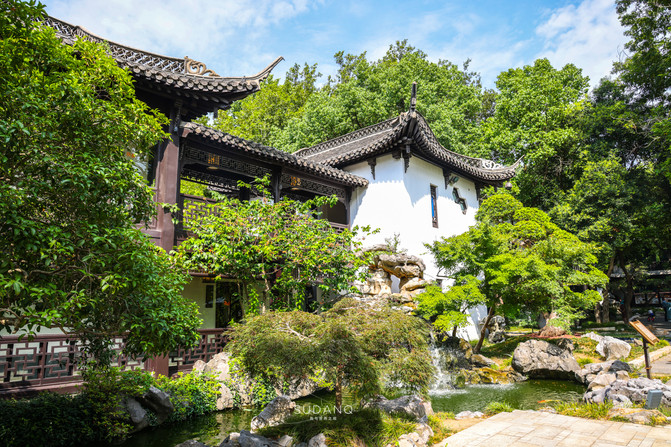
The Quyuan on the bank of Slender West Lake is a must-visit tea house every time I visit Yangzhou. Quyuan, also known as Huangyuan, was originally built by brothers Huang Luxian, a salt merchant in the Qing Dynasty. In the twenty-seventh year of Qianlong (1762), when Emperor Qianlong toured Yangzhou in the south and toured Slender West Lake, he named it "Quyuan".

This is a garden-style tea house with two major scenic spots: "Shuiyun Shenggui" and "Four Bridges Yanyu". There are also pavilions and rockery, small bridges and flowing water, and paths leading to the secluded scenery to give full play to the beauty of the garden. Eating morning tea here is a beautiful enjoyment, as if the beauty of all things is concentrated in the fun garden.




A cup of green tea in your hand, surrounded the table by three or two confidants, watching the swaying willows by the river, listening to the melodious songs of Yangzhou, watching the Slender West Lake closely, overlooking the scenery of the ancient city, and eating hot dried shredded silk, roasted meat, crab roe soup buns, three Ding Bao, thousand-layer oil cake, silver thread noodles...

Since I went to Yangzhou, I have always preferred morning tea more than other delicacies.

Like Quyuan, Yechun Tea House has a history of hundreds of years, and Qianlong also visited it.
Yechun Tea House has many branches. Coincidentally, there is also one on the bank of Slender West Lake (Hongqiao Square Store). Although it is not as integrated as Quyuan, it has a sense of tranquility.

Yechun morning tea is mainly made of Huaiyang fine snacks and snacks, including big boiled dried shredded silk, Wuding buns, crab yellow buns, thousand-layer oil cakes, steamed dumplings, etc.
This is very common in tea houses large and small in Yangzhou, but each chef has its own unique skills, and the same tea has different ways.

The most famous one is the jade roast sale, which has the saying of "unparalleled double arrogance" and has a unique flavor.
Must-order morning tea: hot dried shredded silk, jade roasted meat, crab roe buns, three Ding buns, five Ding buns, silver noodles, shrimp seed dumpling noodles, etc.

02 The prosperity of gardens is the best in the world
Looking at Yangzhou's history, the atmosphere of prosperity comes to your face.
Yangzhou, which is a rich country, is not only materially advanced, but also rich in spiritual culture. Of course, this was also due to the "struggle for wealth" among salt merchants. Demonstrate financial and material resources by building gardens.

Yangzhou gardens have since become famous all over the world. They have not only become a place that literati and literati aspire to, but also a popular tourist attraction among ancient emperors. Kangxi and Qianlong always come to Yangzhou to visit and see when they went to Jiangnan.

Slender West Lake: The prosperity of gardens is the best in the world
When visiting Yangzhou gardens, Slender West Lake is always ranked first. The various "struggles for wealth" of Yangzhou salt merchants in the past can be seen on both sides of today's Slender West Lake.
Slender West Lake has formed a basic pattern during the Kangxi and Qianlong periods of the Qing Dynasty, and is known as "the prosperity of gardens and the best in the world."

According to the records of the "Yangzhou Painting Boat Record", there are twenty-four views of Slender West Lake."The two embankments are all surrounded by the water, and the towers reach the mountains.""The gardens and pavilions of more than ten families are integrated into one, and the momentum is consistent."
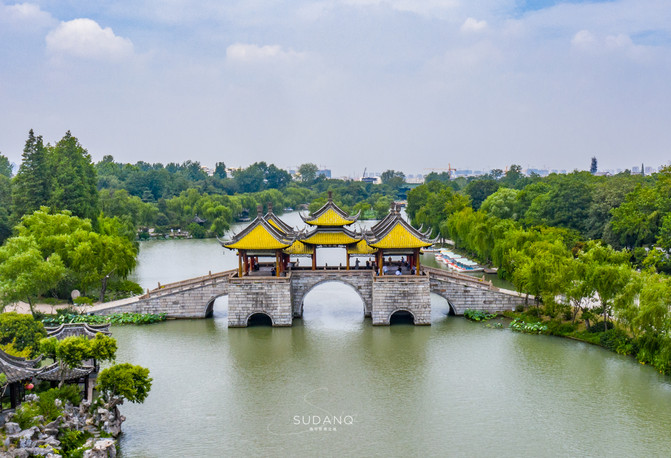




Today's scenery of Slender West Lake includes Dahongqiao, Changdi Chunliu, Wuting Bridge, Xiaojinshan, White Pagoda, Wangchun Tower, Xichun Terrace, etc. In 2014, Slender West Lake, one of the heritage sites of the "Grand Canal of China", was included in the World Cultural Heritage List.

He Garden: The No. 1 Garden in the Late Qing Dynasty
As a model of Yang-style gardens, He Garden is one of the gardens that cannot be missed during a trip to Yangzhou.

He Garden, also known as "Jixiao Villa", is a Chinese classical garden building built in the middle of the Qing Dynasty. It is also a representative work of Yangzhou gardens in the late Qing Dynasty. It is known as the "First Garden in the Late Qing Dynasty".

He Garden was built by He Zhiyan during the Guangxu period of the Qing Dynasty. The stone mountain room is a masterpiece of Master Shi Tao's stacked mountains. The main attractions include Fudao Corridor, Riding Building, etc. The whole park is divided into four parts: East Garden, West Garden, Garden Residential Courtyard, and Pishishan Mountain House.

The biggest feature of this garden is that it gives full play to the function and charm of the corridor building. The 1500-meter complex corridor is a rare sight in Chinese gardens.

It diverges left and right, connects high and low, surrounds mountains and waters, and climbs into the room, forming an all-round three-dimensional landscape and all-weather sightseeing space. It gives full play to the beauty of Chinese garden art and the beauty of extending in all directions. It is the earliest prototype of an overpass in China.

Geyuan: One of the four famous parks in China
Yangzhou people not only know how to do business, but also are passionate about the pursuit of beauty. Today, the beauty of Yangzhou's gardens and the exquisite food all benefit from these salt merchants. Of course, Geyuan is no exception.

Geyuan, one of the four famous gardens in China, is a private garden in the Qing Dynasty. Its owner was a very rich Yangzhou salt merchant at that time.

The beauty of Geyuan's gardens is famous for its planting of green bamboos, and its rockery in the spring, summer, autumn and winter seasons. They are Spring Mountain, Summer Mountain, Autumn Mountain and Winter Mountain respectively, expressing the poetic meaning of "the spring scenery is beautiful and like a smile, the summer mountains are green and like dripping, the autumn mountains are clear and like makeup, and the winter scenery is bleak and like sleeping." It has been praised by Mr. Chen Congzhou, the master of the garden, as an "isolated case in China."


Yangzhou Guesthouse: The "ceiling" of garden hotels
Yangzhou Guesthouse is actually a place for eating and accommodation, but because its garden design is quite exquisite, I can't help but classify it as a "garden"(including Quyuan and Yechun).

Although the layout and design of the hotel room are very simple, the generous and decent temperament makes people feel very comfortable. Of course, the main reason for staying in the guesthouse is that it is attracted by its classical architectural style.





The pavilions and pavilions in the park are full of flowers and lush trees, and winding flowing water. They face the Xuyuan of Slender West Lake Park, Siqiao Yanyu Building, and Changdi Chunliu across the water.

When I woke up early in the morning, I stood by the window and looked out. The blue-tiled roof formed a beautiful scene with the distant trees and stupas. The joy of harvest was beyond words. I can't help but envy Yangzhou people: there are exquisite food, exquisite scenery, and exquisite life.
03 Huaiyang Cuisine: The Real Leading Role of Yang School Food
Some people say that Yangzhou is a garden city that you can taste just by eating. In the past, Yangzhou salt merchants were not only extremely attentive to garden design, but also passionate about food.

The classic representative of Yang-style food is mainly Huaiyang cuisine, whose characteristics lie in taste and its art lies in style. Eating Huaiyang cuisine in Yangzhou is both a taste and a view.

It is light and elegant, full of literati temperament, and the form of setting the plate is full of the art of blank space of Chinese painting; it pays attention to the original taste and is exquisite in knife techniques, and is full of "food is not tired of fine, but it is complex to fine, but the taste and shape are light and indifferent, using the most elegant scholarly style to make the most elegant fireworks in the world.
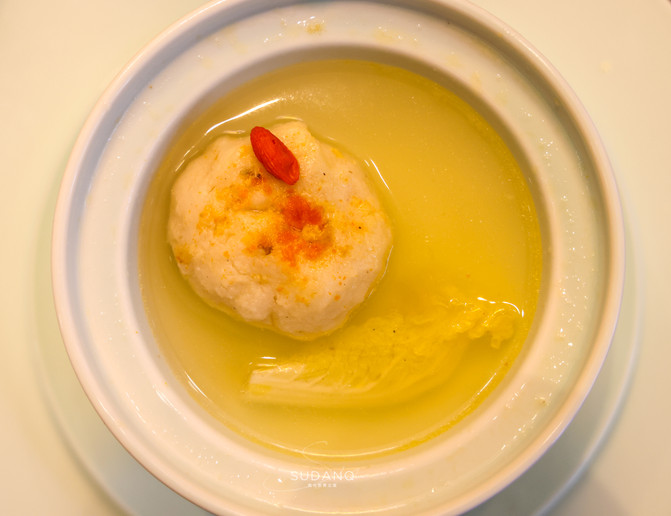
In short, Huaiyang cuisine is clear and fresh, fresh and light. Signature dishes include lion's head, salted goose, Wensi tofu, Gaoyou double yellow eggs, etc. Recommended restaurants: Canying Villa, Yangzhou Banquet, Canal Banquet, Yechun, 7 Eat 8 Bar, Wanfeng Hotel.

Canying Villa: Garden Restaurant in Slender West Lake
I was deeply impressed by the Canying Villa located in the Slender West Lake Scenic Area. It is a poetic experience to enjoy the delicious Huaiyang cuisine here.

Canying Villa is located at the southwest corner of Wanhua Garden near the east gate of Slender West Lake. The exterior is modeled after the residential Canying Villa of Yu Jizhi, a great gardener in Yangzhou in the early years of the Republic of China. The exterior adopts Yangzhou's traditional classical garden architectural style. Here, you can not only eat authentic Huaiyang cuisine, but also experience authentic specialty morning tea, which is the main product of "Yangzhou Brand".
Yangzhou Banquet: The filming place of "Twelve Tastes of Sharp Flavors"
Yangzhou Banquet is one of the high-end restaurants that eat authentic Huaiyang cuisine. It is also the filming place of "Twelve Ways of Fengwei". The elegant Chinese-style environment reflects the antiquity of a city.

The Yangzhou Banquet not only includes traditional Huaiyang snacks, but also exquisite Huaiyang dishes, which integrate freshness, neutrality, fashion and health preservation. There are classic Gaoyou double yellow duck eggs, steamed green crab with onion flavor meat pie, raw baked large yellow fish in casserole, Gaoyou Wang tofu and other delicacies can be said to be a Jiangnan flavor of Mr. Wang Zengqi's "World Vegetation" local banquet.

Canal Banquet: Internet celebrity restaurants around the museum
The Canal Banquet located next to the China Grand Canal Museum is also a very popular Huaiyang cuisine restaurant in Yangzhou: Visiting the museum and eating Huaiyang cuisine has become a daily routine for me during my trip to Yangzhou.

The Beijing-Hangzhou Grand Canal is world-famous. It starts from Yuhang (now Hangzhou) in the south and ends in Zhuojun (now Beijing) in the north, with a total length of about 1797 kilometers. The ancient Grand Canal not only connects many cities, but also blends the north and south flavors. This is vividly reflected in the China Grand Canal Museum.

When I came out of the museum and went to the Canal Banquet for lunch, the ancient culture of the Canal instantly became three-dimensional, vivid and delicious.


The food at the Canal Banquet includes Huaiyang cuisine, food from Beijing, and scenery from Shandong... Feel the history and culture of the Grand Canal through the food, and the Canal Banquet must not be missed.

Yechun: It is both a tea house and a Huaiyang cuisine restaurant
During my five-day and four-night trip to Yangzhou, I chose Yechun for breakfast and dinner one day. Not only is it right next to my hotel (Huajiantang), but also because the Huaiyang cuisine here deserves my decision.
Recommended dishes: Four pieces of fragrant goose, three delicacies lo noodles, pan-fried buns, fried chrysanthemum head in oil, squirrel mandarin fish, dragon boat fish, leek fragrant soft bag, lily tangerine peel duck Gu.

But what is even more exciting is that you can still listen to music while tasting delicious food. It really feels like a trance of time and space. It is extremely wonderful.

7 Eat 8: New Huaiyang Cuisine
Located on the bank of Slender West Lake, 7 Eat 8 Bar Sunshine Restaurant is a well-known restaurant in Yangzhou. It is a new Huaiyang cuisine restaurant. Here, there are both the original flavor of Huaiyang cuisine and the innovation of integrated cuisine.

Wanfeng Hotel
During my recent trip to Yangzhou, I ate many restaurants that specialize in Huaiyang cuisine. Every one is unforgettable to me, and it is difficult to compete. Wanfeng Hotel, located at the south gate of Weilan Building, No. 102 Shugang West Road, Hanjiang District, is also a good Huaiyang cuisine restaurant.

The Huaiyang cuisine of Wanfeng Hotel not only retains the tradition, but also innovates. Recommended dishes: fish and lion head, salted goose (a favorite in Huaiyang dishes), boiled dried shredded rice (one of Yangzhou's traditional famous dishes), signature crab roe tofu, Boston lobster in golden soup, Wanfeng roast duck, chicken soup, black tiger shrimp smooth.
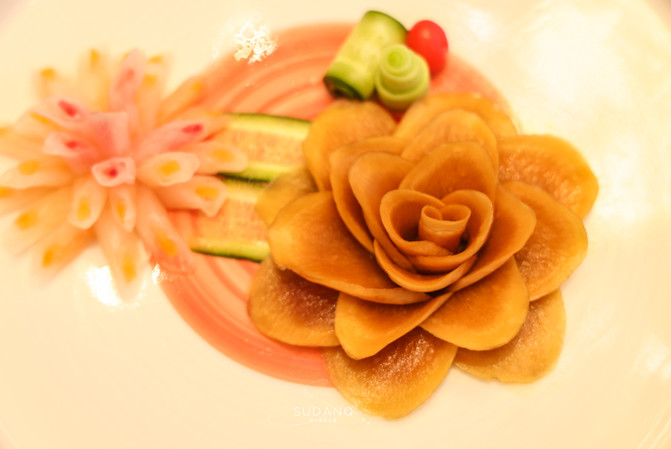
It is worth mentioning that the chefs in this hotel are really good at cutting skills. The exquisite cold plates served are particularly exquisite in shape, and the superb cutting skills are clear at a glance.
04 Ancient city culture: The long river of history has set off prosperous and brilliant storms
When it comes to Yangzhou's history and culture, the canal made a beautiful beginning and also allowed Yangzhou to start three periods of prosperity in different periods.

In the Western Han Dynasty, Liu Bi, the king of Wu,"forged money from mountains and boiled the sea into salt", and opened a "salt river" on the basis of Hangou, opening Yangzhou's first prosperous period.
After the Sui Dynasty unified the north and south, the Grand Canal was successively excavated with Luoyang as the center, and Yangzhou ushered in a second period of prosperity.

During the Ming and Qing Dynasties, the political center of the dynasty was in Beijing and the economic center in Jiangnan. The importance of shipping and transportation was self-evident. Yangzhou, located at the intersection of the Yangtze River and the Grand Canal, once again prospered.
China Grand Canal Museum: Currently the most popular museum in Yangzhou
This is not only the most popular museum in Yangzhou at present, but also one of the must-visit places to understand the history and culture of China's Grand Canal.

The China Grand Canal Museum is a local modern comprehensive museum integrating cultural relics protection, scientific research exhibitions, and leisure experience. It is a landmark project in the construction of the Grand Canal National Cultural Park.

The main building of the museum consists of five parts: the exhibition hall, the inner courtyard, the square in front of the museum, the Universiade Tower and the Jinyue Bridge. Among them, the museum, tower and bridge complement each other. Climbing the tower, you can overlook the historical landscape of "Three Bays and One Dam". The overall tone of the museum is in the Tang Dynasty architectural style, shaped like a ship, reflecting the historical value of the Grand Canal.

As of the end of 2021, the museum has more than 10,000 pieces (sets) of ancient books and documents, calligraphy and paintings, inscriptions, ceramics, metal ware, miscellaneous items and other cultural relics that reflect the theme of the canal from the Spring and Autumn Period to the present.

There are two basic displays: "The Grand Canal-China's World Cultural Heritage" and "Born by Transport-Impressions of the Grand Canal Street", as well as "Boat on the Canal","Seeking Fun in Canal Wetlands" and "Damingdu Water Supervision". There are 9 special exhibitions such as "The Lost Track of the Canal".

It is worth mentioning that the recent special cultural exhibition came from Luoyang, the ancient capital of the canal.

Hanlingyuan: One of the rare large-scale tombs in the country
Among the list of must-check museums in the city, Hanling Garden in Yangzhou is slightly niche and unpopular. But it was this small "secret realm" that made me feel particularly devoted and selfless when I visited Hanling Garden.

Hanling Garden, also known as the "Han Guangling King's Tomb Museum", is the No. 1 Western Han Dynasty tomb excavated in Shenju Mountain, Gaoyou Huxi New District, Gaoyou City in 1979. The area of wood and purple is 18 times larger than that of the Han tomb in Mawangdui, Hunan. It represents the funeral of the highest etiquette in ancient times, and fragments of gold strands and jade clothes were unearthed.
Preliminary research has been made that the owner of the tomb is the tomb of Liu Xu, King of Guangling of the Western Han Dynasty, and his wife buried in the same tomb in a different cave.

The tombs of Liu Xu, King of Guangling of the first generation of the Western Han Dynasty, and his queen are displayed in the garden. They are imperial level "Yellow Chang Tizui" wooden coffin tombs ("Yellow Chang" refers to yellow-heart cedar trees, and "Tizui" refers to the structure formed by the header being pieced together inward). It is large in scale and rigorous in structure. It is one of the rare large-scale tombs in the country, with a history of more than 2,000 years.

The tomb of the queen was unearthed successively with the tomb of Liu Xu, King of Guangling. It belongs to the imperial "Yellow Chang Tiqian" burial system and was moved to Yangzhou at the same time.
More than 300 cultural relics were unearthed from the Queen's Tomb, including the inscription of the "Sixty-second Year" and the seal of the "Guangling Private Mansion", which provided reliable written data for us to determine the identity and status of the tomb owner.

It is worth mentioning that a large number of eating utensils and a complete set of bathing utensils were also unearthed in the tomb, indicating that Yangzhou's food culture and bathing culture can be traced back to the Han Dynasty more than 2,000 years ago.

Tangcheng Ruins Museum: Currently one of the most well-preserved ancient city ruins in China
Speaking of the prosperous metropolises during the Tang Dynasty, we always think of Chang 'an and Luoyang, and few people will mention Yangzhou in the Jiangnan area at once.
The Tang Dynasty's national strength was at its peak. Yangzhou, as the north-south transfer center, also reached its peak. It became the largest city in southeastern China at that time."The world's prosperity is the first place". It was the third largest city and the largest commercial city after Chang 'an and Luoyang. city.

The Tangcheng Site in Yangzhou is currently one of the most well-preserved ancient city sites in China and a good place to experience the prosperity of Yangzhou in the Tang Dynasty. In 1996, the State Council designated and announced the Yangzhou City Site as a national key cultural relic protection unit.

The Tangcheng Ruins Museum houses more than 300 cultural relics of various types, mainly including stone carvings, city bricks, pottery, porcelain, bronzes, woodware, calligraphy and painting, etc.

Daming Temple: The first of the eight famous temples in Yangzhou
Daming Temple is one of the most famous ancient temples among Yangzhou's many ancient temples. In the prosperous years of Kangxi and Qianlong Dynasties of the Qing Dynasty, Daming Temple was expanded to become the first of the eight famous temples in Yangzhou. Daming Temple was first built during the Ming Dynasty of Emperor Xiaowu of the Southern Song Dynasty and has a history of more than 1500 years.

The main buildings of the temple include archway, Tianwang Hall, Pingshan Hall, Jianzhen Memorial Hall, Qiling Tower, etc. Among them, Pingshan Hall, Jianzhen Memorial Hall and Qiling Tower are in my opinion the three major landscapes that cannot be missed during a trip to Daming Temple.

[Pingshantang]
During the Qingli period of the Northern Song Dynasty, Pingshan Hall was built when Ouyang Xiu was appointed prefect of Yangzhou.
The environment here is quiet and simple. In front of the hall, ancient vines are staggered, and plantains are fat. Above the open hall in the hall style, a plaque with the three characters "Pingshantang" hangs high. The hall is an open hall with five rooms wide.

Sitting in this hall, you can see the mountains in the south of the Yangtze River in your mind and seem to be level with the hall, hence the name Pingshan Hall. Pingshan Hall is a place dedicated to literati and literati reciting poems and composing poems. It is deeply favored by elegant scholars and praised the splendor of this hall as the first in Huainan.

[Jianzhen Memorial Hall]
Part of the reason why I like Daming Temple is because of Mr. Liang Sicheng. He designed the Jianzhen Memorial Hall.

The Jianzhen Memorial Hall is elegant and simple, preserving the architectural art style of the Tang Dynasty. In September 2016, Jianzhen Memorial Hall was selected into the "First Batch of China's 20th Century Architectural Heritage" list.

[Qi Spirit Tower]
The Qiling Tower was first built in the first year of Renshou of Emperor Wen of the Sui Dynasty (601 AD). The tower is nine stories high.

During the Sui and Tang Dynasties, Yangzhou's economy developed rapidly. Famous poets Li Bai, Gao Shi, Liu Changqing, Liu Yuxi, Bai Juyi, etc. have all climbed to the Qiling Tower and wrote poems and praises. Unfortunately, this tower was destroyed one generation in the third year of Huichang, Wuzong of the Tang Dynasty (843 AD).

Later generations rebuilt it based on documentary materials and descriptions of it by literati and literati. The style is imitating the Tang Dynasty. There are four pillars and three rooms on each side, east, west, north and south, one door and two windows. The waist eaves of the flat seat and eaves are supported by a bucket arch. The eaves are large and flat. The columns are in the shape of a waist drum and a window shaped straight lattice. In the twilight, the Spirit Pagoda reproduces the style of the Tang Dynasty.
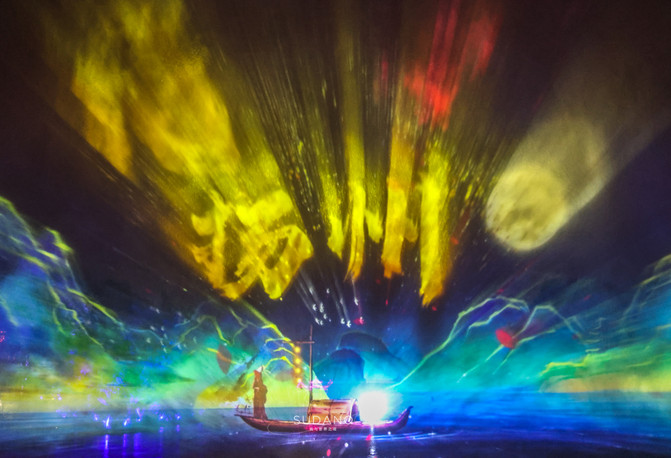
05 Yangzhou summer, the nightlife of Slender West Lake is the perfect holiday
Night Tour of Slender West Lake: Charming Light Show tells the story of Yangzhou

No matter how many times you come to Yangzhou, you must always visit Slender West Lake.
During Emperor Qianlong's six southern tours, Yangzhou was a must-stay place, and Slender West Lake was a place he admired under his pen and ink.

Slender West Lake has formed a basic pattern during the Kangxi and Qianlong periods of the Qing Dynasty, and is known as "the prosperity of gardens and the best in the world." Its picturesque scenery left a deep impression on me. Slender West Lake during the day is like a classical garden landscape painting. When the scroll is opened, it presents the artistic conception of "Fireworks under Yangzhou in March".

But have you ever imagined the night of Slender West Lake? I wonder if Qianlong also traveled to Slender West Lake at night.

Visiting Slender West Lake at night is completely different from during the day. In addition to the comfortable temperature, there are also infinitely exciting light shows. In this "crisscross of light and shadow", and through different forms such as landscape, performing arts, food, intangible cultural heritage, and interaction, the history, humanities, and beautiful scenery of Slender West Lake and Yangzhou are presented more three-dimensional, vividly and vividly.


Slender West Lake Night Market: Night Bridge Lights and Stars
This is a very young and fashionable night market, and the first impression it gives is fashionable, vibrant and full of vitality. The night market is large in scale, distributed in an L shape on the bank of Slender West Lake, and consists of two parts: Inner Street and Outer Street.

The inner street is dominated by traditional local specialties of Yangzhou. The outer street is full of national trends, including fashion bars, food areas, cultural and creative areas, business areas, interactive experience areas, etc., and tents and camping formats are arranged in appropriate locations in the neighborhood.

The environment and atmosphere of the entire night market reflect the classical artistic conception of fashion, poetry and romance. The bustling shops present the dream of traveling through time, recreating the prosperity of Yangzhou in ancient times,"the night bridge lights connect the stars" and "the night market lights shine on the blue clouds". scene. If you are in Yangzhou, don't miss this place.

06 Summer Tour in Yangzhou, 5 days and 4 nights itinerary reference
D1 Wuhan-Yangzhou
Stay in Huajiantang (next to Slender West Lake, Dahongqiao Road Store)-7 Eat 8 Bar (dinner)--Night Tour of Slender West Lake--Slender West Lake Night Market

D2 Quyuan (Morning Tea)--Daily Tour of Slender West Lake--Daming Temple--Yangzhou Banquet (Dinner)
Since the Yangzhou Banquet is next to the Slender West Lake Night Market, you can continue to visit the Slender West Lake Night Market after dinner, then return to the hotel to rest, and still stay in Huajiantang.

D3 Yechun (morning tea)--Take a boat from Dongguan Gudu Wharf to the China Grand Canal Museum (you can also take a car)--Songjiacheng--Yechun (dinner)--Overnight at Songjiacheng Resort Hotel

Yechun (Slender West Lake Store) is right next to Huajiantang, just a 1-2 minute walk. Morning tea and Huaiyang cuisine in this restaurant are very missed.
Due to the large scale of the China Grand Canal Museum, it is recommended to set aside half a day. You can choose for lunch at the Shifang Restaurant on the ground floor of the museum (or the Canal Banquet outside the museum).

Among them, there are four major packages that must be tasted: Intangible Cultural Heritage Package (88 yuan), Canal Package (58 yuan), Yechun Package (38 yuan), Business Package (68 yuan).

D4 Zhuyi Bay Park (Yangzhou Zoo)--Geyuan--He Garden--Overnight at Yangzhou Guest House
I will not introduce Geyuan and He Yuan here. Focus on sharing Zhuyi Bay Park. It is located in Wantou Town, Dongshou, Yangzhou and is a national 4A-level scenic spot. There is also a Yangzhou Zoo in the scenic area, including Giant Panda, Monkey Island, Beast Garden, Herbivorous Animal Area, Sea Lion Performance Hall, etc. It is more suitable for weekend parent-child tours, so self-driving is recommended.

D5 Hanling Garden-Tangcheng Ruins Museum-Return (Wuhan)
Hanling Garden and Tangcheng Ruins Museum are next to each other. Although the main building of the museum is not as large as the China Grand Canal Museum, its visibility index is also very high. It is recommended that when visiting these two museums, you must find a docent to accompany you, otherwise you will lose a lot of fun.
Previous Article:Chunfeng Shili Yangzhou Road
